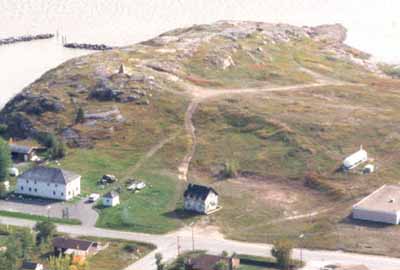Fort Chipewyan National Historic Site of Canada
Fort Chipewyan, Alberta

Aerial view
(© Parks Canada | Parcs Canada)
Address :
Fort Chipewyan, Alberta
Recognition Statute:
Historic Sites and Monuments Act (R.S.C., 1985, c. H-4)
Designation Date:
1930-05-16
Dates:
-
1788 to 1788
(Construction)
-
1792 to 1793
(Significant)
-
1798 to 1798
(Significant)
Event, Person, Organization:
-
Sir Alexander Mackenzie
(Person)
-
Roderick Mackenzie
(Builder)
Other Name(s):
-
Fort Chipewyan
(Designation Name)
-
Old Fort Point #1
(Other Name)
Research Report Number:
2009-CED-SDC-066, 1968-029
Plaque(s)
Existing plaque: 109 MacKenzie Avenue, Fort Chipewyan, Alberta
Headquarters for “the famed Athabasca, the delight and school of the North”, Fort Chipewyan was once the richest trading post in North America. The original fort, from which Alexander Mackenzie set out on his journeys to the Arctic and Pacific, was built by his cousin, Roderic McKenzie, across the lake on Old Fort Point in 1788. In About 1800 the North West Company moved the post to this shore, from which it dominated the northern trade. After 1821, under the management of the Hudson’s Bay Company, Fort Chipewyan continued to play a major role in the fur trade for over a century.
Description of Historic Place
Fort Chipewyan National Historic Site of Canada is an archaeological site located at Old Fort Point, south-east of the present-day town of Fort Chipewyan, in Alberta. Established in 1788 as the centre of northern trade, the fort sits atop a high rocky knoll overlooking Lake Athabasca. The site includes archaeological vestiges such as two large chimney piles, a large cellar pit, and four smaller pits. Official recognition refers to a polygon located on Old Fort Point, on the south side of Lake Athabasca.
Heritage Value
Fort Chipewyan was designated a national historic site of Canada in 1930. It is recognized because: from its foundation in 1788 it was an important post and the centre of the northern trade, and was once the richest trading post in North America; it was the starting point of Sir Alexander Mackenzie's expeditions to the Arctic, 1789, and Pacific oceans, 1792-1793. Indigenous Peoples, their territories, and labour were foundational to the fur trade in North America. Posts were often built near existing Indigenous settlements, trading routes and/or meeting places and became important sites of economic, social and cultural exchange.
The heritage value of Fort Chipewyan lies in its evocation of the prosperous northern trade posts known under the same name. In 1788, Roderick Mackenzie of the North West Company established Fort Chipewyan at Old Fort Point on the south shore of Lake Athabasca. The abundant fur resources in the area made the location optimal for a fur trading post. By the early 19th century, however, ice breakage patterns of the lake, the proximity of trade, and the dilapidated state of the fort prompted John Finlay of the North West Company to relocate Fort Chipewyan two times, about 32 kilometres (20 miles) north-west to the northern shore of Lake Athabasca. The trading post quickly became the richest in North America. Fort Chipewyan continued to play a major role in the fur trade for over a century.
The heritage value of the first Fort Chipewyan also lies in its association with Sir Alexander Mackenzie and his expeditions. It was a starting point for Roderick Mackenzie’s cousin Sir Alexander Mackenzie, who led an expedition from the site down the Mackenzie River to the Arctic in 1789. He also departed from Fort Chipewyan on his journey to the Pacific in 1792-1793.
Sources: Historic Sites and Monuments Board of Canada, Minutes, September 2009, December 2020; Plaque Text, 1932; 1977.
Character-Defining Elements
Key elements that contribute to the heritage character of the site include: its location at Old Fort Point southeast of the present-day town of Fort Chipewyan associated with the two following Fort Chipewyan, in Alberta; its setting atop a high rocky knoll overlooking Lake Athabasca; the relatively undisturbed remains from the 1788 fort including two very large chimney piles, a large cellar pit, and four smaller pits; the integrity of any surviving or as yet unidentified archaeological remains which may be found within the site in their original placement and extent; viewscapes from the site across lake Athabasca.